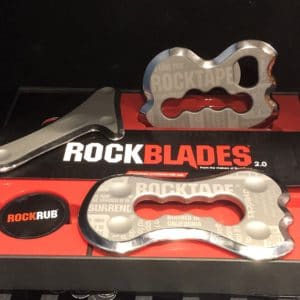Rock Blades Graston Scraping IASTM. Instrument Assisted Soft Tissue Mobilization: A beginner’s guide to what it is, how it works, and which tools to pick.
IASTM: Instrument Assisted Soft Tissue Mobilization
IASTM as a broad technique has many names. From it’s origins Gua Sha an ancient Chinese technique of scraping the skin with a massage tool to help mobilize soft tissue. It’s long been know technique improves blood and neurological connectivity to muscle fascia. RockBlades FMT, Graston, Scraping, all refer to this Guar Sha broadly. Graston and FMT are specific brand names of the tools and techniques these companies use to market their certification and tools.

Purchasing a Good IASTM Toolset
There are three major differences in the materials that companies make. In general, more expensive is better. More expensive blades/tools better transfer the feeling of bonded fascia to the personal trainer / therapist. The better blade allows for better scanning and more control. Having used both cheaper blades and more expensive blades, I can tell you that you should always buy the most expensive tools you can afford. It’s better to have one very expensive tool than 5 mediocre tools.
IASTM Tools That I Use
If you are planning to do scraping / myotherapy work on yourself, you can get away with buying cheaper tools. You don’t need the additional feedback provided by the higher end tools.
Machined vs Casted Scraping Tools
So Machined IASTM tools are developed from a single piece of metal. Casted scraping are made from multiple pieces that are welded together. Machined tools cost more to make and better translate feedback to the therapist / personal trainer.
Polished IASTM Tools vs Chrome Plated Scraping Tools
Polishing the metal to a shine removes the pores in the metal that can otherwise trap bacteria. Chrome plating is cheaper and eventually comes off.
Stainless Steel vs Chrome vs Aluminum IASTM Tools
This should be a no-brainer … hospitals around the world use stainless steel for a reason. It’s durable, cleans well, and is largely nonreactive.
Single vs Double Edged Blades
You can get away with using single edge blades … especially on your own. Having a two side blade makes the tool more versatile for use in both hands. It’s also annoying to pickup a tool and have to flip around everytime you set it up on the “non-edge.” Kind of like trying to plug-in a USB cord upside down.
Sand & Steel IASTM Tools
Both the Rock Blades and Myofascial Releaser comes with very nice kits. The tools are very different, but they are of comparable quality. I like them both and regularly use both sets.
How to Administer Instrument Assisted Soft Tissue Mobilization
- Step 1. TEST. The #PersonalTrainer must also determine which muscles are over-activated and which tissues are under-activated. There are many techniques to determine muscle activation as well, but functional movement testing, strength testing, and humuculous testing are common.
- Step 2. SELECT. Based on the results of #TheTest, the personal trainer must select the IASTM #mobility technique to use. One makes his or her selection based on the tissue restriction or injury present. There are many techniques available, but mobilization techniques such as up-regulation, down-regulation, tissue-glide, and combinations are the #MostPopular.
- Step 3. ADMINISTER. Administer the #IASTM technique.
- Step 4. RETEST. The muscle function to see if strength and/or range of motion has improved. Retest to see if #pain in the motion has decreased.
- Step 5. #KineticTAPE. Applying #Rocktape Kinetic tape to the newly activated muscle is very effective at increasing.
Upregulating FMT Mobility Blades Technique
1-3 Intensity with 180 BPM (same as running coincidentally). Stimulates Pacinian Corpuscles to increase mind muscle connection. Same intensity is used as a scanning technique.
Downregulating and Gliding
Pin & Stretch. Downregulates the ruffini nerves. This technique is used to help stop overactive muscles from firing as much. Glide Technique: slid with moderate force until you feel knots or pain then working chopping motions
Top Shoulder Pain Example – Treatment with IASTM
Testing reveals a problem with Engagement Timing. Select Upregulation of the rear deltoid, and downregulation pectoralis major. Recommended stretches of chest muscles to further downregulate the tissue.
As shown in the figure to the right, a big part of Graston and IASTM is understanding where the muscles are, and where they connect. There is a whole study of upstream and downstream pain caused by compensation. For a member experiencing neck pain and anterior shoulder pain, one might want to look for tight or weak muscles in the rhomboids and trapezious (shown in green). Take care not to scrape on any bony surfaces (shown in red) of blood vessel.
Of course, IASTM, Rock Blades, and Graston are complex certifications that take a look time to perfect. Done incorrectly they can lead to injury… please contact a certified mobility provided before having instrument-assisted soft tissue mobilization performed.


